KINO PRAVDA 15 (1923):
conference on disarmament, atheistic propaganda, Timiryazev monument opening, promotion of sport
SILENT FILM WITH RUSSIAN INTERTITLES AND SWITCHABLE ENGLISH SUBTITLES. APPROXIMATELY 16 MINUTES
KINO PRAVDA 17 (1923):
The First All-Russian Agricultural Exhibition
SILENT FILM WITH RUSSIAN INTERTITLES AND SWITCHABLE ENGLISH SUBTITLES. APPROXIMATELY 15 MINUTES
KINO PRAVDA 18 (1924):
Kino-Pravda No. 18 takes the viewer from West to East; Kino-Pravda 19, from North to South. Kino-Pravda No. 18 ("A race in the direction of Soviet reality"), was conceived as a journey on more than one level. It looks like a journey because Vertov starts with found footage filmed in Paris, and moves on to the footage shot in Russia, and it certainly feels like one — for the sequence that links Paris and Moscow has been assembled from travelling shots. It is not just a camera race, it is a relay race: Vertov edits together various kinds of camera movement, reflecting the camera’s mode of transport. We are first taken up the Eiffel Tower, its magnificent girders slowly gliding by (this movie-camera ascent, the title tells us, is dedicated to the memory of the tower’s builder — Gustave Eiffel died in 1923). From there, a plane takes over. A title, "The movie camera lands in the territory of the USSR," is followed by a shot taken from the undercarriage of a descending airplane, as fields and meadows loom up rapidly below us. As the movie camera lands, it is taken over by a racing car ("Auto race Petrograd-Moscow," the title reads). This is perhaps the closest Vertov’s film practice ever came to his somewhat elusive theoretical concept of "intervals", formulated in his manifesto "We" in 1922: "Kinoculism is the art of organizing the necessary movements of objects in space as a rhythmical artistic whole, in harmony with the properties of the material and the internal rhythm of each object. Intervals (the transition from one movement to another) are the material, the element of the art of movement, and by no means the movements themselves. It is they (the intervals) which draw the movement to a kinetic resolution."
As usual, smychka (announced by its signature emblem, the handshake) is one of the dominant themes in Kino-Pravda No. 18, but here Vertov decides to illustrate it in an off-beat way. The movie camera picks out a bearded man in the crowd, who turns out to be a peasant, Vasilii Siriakov, who has come all the way from Yaroslav Province to see Moscow, and the camera shows us Moscow through the peasant’s eye. "The movie camera pursues him," a title announces, whereupon a shadow of a man cranking a movie camera is shown. "The same peasant on his way to the Agricultural Exhibition" — and Siriakov is shown riding on a tram, all the while observing the tram conductor and the driver at work. The camera shadows our peasant everywhere. At one point he winds up in a Goskino workshop — at the moment when a baby is being Octobrized. What does this mean, "Octobrized"? The same as baptized — but in a workers’ collective instead of a church, and into Communism rather than a religion. (Invented with an eye to replacing church christening, this stopgap ritual never took root.) What is the best name for a newborn boy? You guessed it — and in an extreme close-up, we see the name "Vladimir" emerging from a worker’s mouth. All present are singing (guess which song?) as the boy is passed around — from a Communist worker to a Komsomol youngster and to a Young Pioneer. "To the Red Citizen Vladimir" (more singing faces) "grow healthy, Comrade" (close-up of hands holding the baby in the air). Workers at work. "Vladimir." Machine-tools at work. "Vladimir." The editing accelerates. "Vladimir." And intercut with all this, the recurrent shadow of the man with the camera, at work.
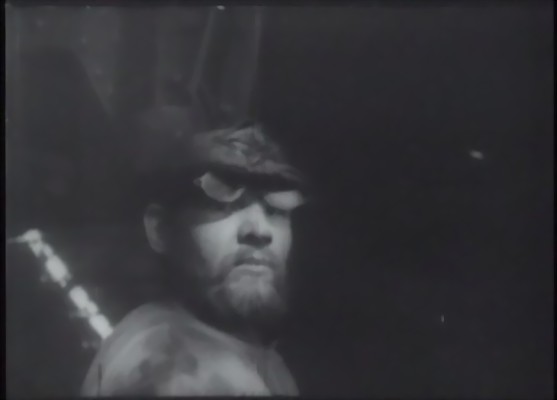
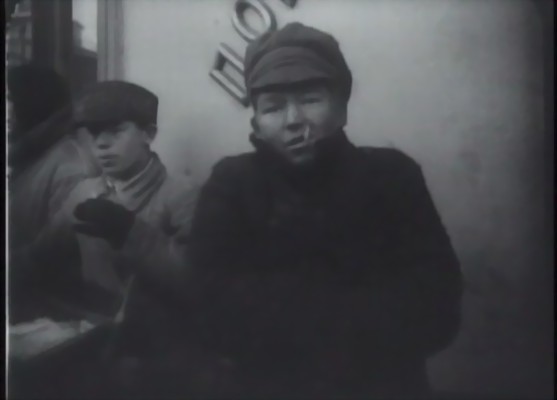
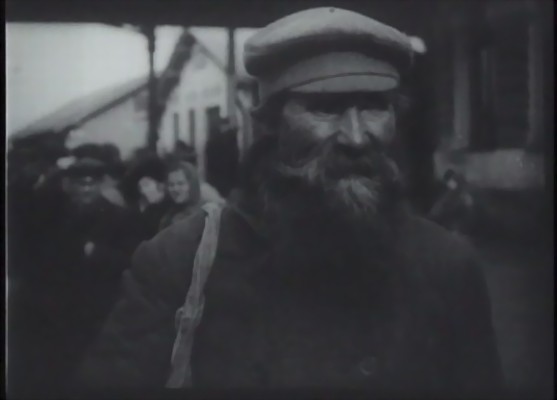
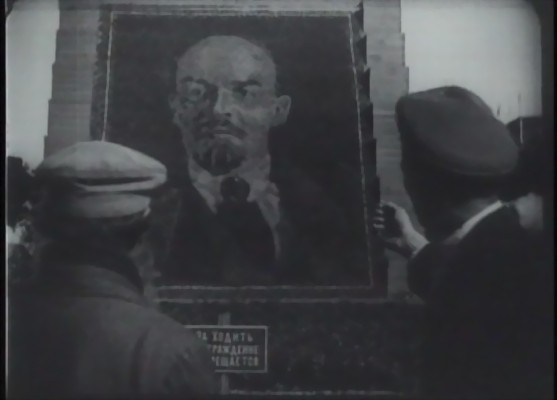
SILENT FILM WITH RUSSIAN INTERTITLES AND SWITCHABLE ENGLISH SUBTITLES. APPROXIMATELY 13 MINUTES
KINO PRAVDA 19 (1924):
Issue 19 tries to do many things at once — maybe a little too many for one reel. First, it contrasts cold and hot, winter and summer, Russia’s arctic regions and Russia’s Southern sea (named Black). Perhaps Eisenstein had a point when he said, with his usual deadly wit, that Vertov’s dream was to lick Nanook and Moana in one fell swoop (see the chapter "Vertov versus Eisenstein" in Lines of Resistance). Secondly, Vertov dedicates this issue of Kino-Pravda to "Woman, peasant woman, worker woman", a theme which defines the dominant gender of this film, particularly towards the end. A young woman types; another woman milks a cow; another works a field, etc. Women in politics: a State woman speaks; Lenin’s wife and sister — shown at Lenin’s funeral, and by his side when he was still alive. And at the very end, pro domo sua: "The editing of the negative for Kino-Pravda No. 19," says the title, and Vertov’s wife, the kinoc editor Elizaveta Svilova, is shown editing the very film we are watching. Déjà vu? If so, then in reverse: there is a similar sequence in Man with a Movie Camera, a film yet to be made.
There is also another sequence in Kino-Pravda No. 19 which anticipates a similar trick from Man with a Movie Camera (and, in a strange way, brings to mind that early British film, How It Feels to Be Run Over). This issue, as the one released before it, is a camera race, so images of women doing different jobs are connected by a recurrent subject: a train in movement, often with the movie camera mounted on the car roof. At one point a curious intertitle informs us: "4 metres of movie-camera memory, as it falls under the wheels of the freight train." The huge wheels flash by; a view from under the train. That’s it. The last 4 metres of what the movie camera remembers. Evidently, in the eyes of the kinocs their kino-eye was a living being
SILENT FILM WITH RUSSIAN INTERTITLES AND SWITCHABLE ENGLISH SUBTITLES. THIS FILM HAS NO SOUND AT ALL. APPROXIMATELY 16 MINUTES.
KINO PRAVDA 20 (1924):
Tour the pioneers (members of ?hild communist organization) in the village and zoological garden
SILENT FILM WITH RUSSIAN INTERTITLES AND SWITCHABLE ENGLISH SUBTITLES. APPROXIMATELY 12 MINUTES.
ALL FILMS HAVE HAD MUSIC ADDED TO THEM WITH THE EXCEPTION OF KINO-PRAVDA 19.
TOTAL RUNNING TIME: 72 MINUTES.
KINO GLAZ (1924):
Dziga Vertov, whose renegade approach to cinema is best remembered in the legendary Man With a Movie Camera and his series of Kino-Pravda newsreels, demonstrates his mastery of montage in this 1924 feature previously unseen in the U.S. An outspoken critic of the purely plot-driven motion picture, Vertov challenged other filmmakers to rebel against the Western story-oriented cinema. Vertov argued that filmmakers should use their camera to capture "the chaos of visual phenomena filling the universe" and through clever editing, develop these random images into a more honest, more genuine record of the Soviet experience.
Central to Kino-Eye are the activities of the Young Pioneers, a group of Soviet adolescents committed to serving the needy. These scenes of teen philanthropy are interwoven with playful cinematic experiments, as when Vertov charts the evolution of hamburger and bread by following its trail back to the farms and wheatfields from whence it came, and a ballet of high-diving that is eerily similar to the famous sequence in Leni Riefenstahl's Olympia.
Kino-Eye is thus a fascinating film, not just for its aesthetic beauty and political significance, but for honestly documenting a society fresh from revolution, buoyed by idealism, ready to face the challenges of a difficult future. The final reel of Kino-Eye no longer exists, but has been approximated by the use of carefully selected outtake footage.
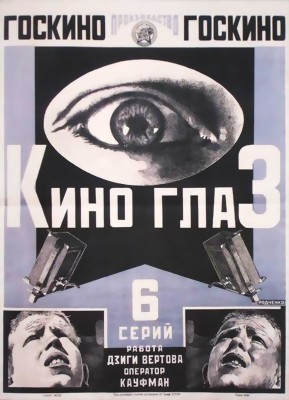
SILENT FILM WITH RUSSIAN INTERTITLES AND SWITCHABLE ENGLISH SUBTITLES. APPROXIMATELY 83 MINUTES.
KINO PRAVDA 21 (1925):
A worker from Lenin Factory tells of the assassination attempt on Lenin. Memorial at the scene of the attempt. Gun with which Lenin was wounded. Lenin after the attempt. Scenes from the Civil War, map of 1919, Lenin's speeches from the time of the Civil War. Red Army detachments marching. Soldiers taking an oath. Lenin's speeches. Komintern session, Lenin's speech. Demonstrations in Central Asia, veiled women march, scenes of unveiling in front of the camera. Children marching. Soldiers, mass demonstrations, tractors ploughing the soil. Machines working. 1921, crisis, hunger, epidemics, Lenin's speeches. New Economic Policy, a fair in Nizhnii Novgorod. Machines in factories and in the fields. 1922-23, news about Lenin's health: temperature, pulse, breathing - presented with the help of animation. Announcement of Lenin's death on January 21, 1924. Lenin in the coffin, masses of people coming to the House of the Soviets for a farewell ceremony. Krupskaia, Zinoviev, Kamenev, Stalin, Kalinin, Rykov, Iaroslavskii, and other politicians around the coffin. Klara Zetkin, Carl Radek. Dzerzhinskii, Frunze, Stalin, Voroshilov, Budennyi. Orchestra, a group of soldiers, pioneers passing by the coffin. Crowds on the streets. Cartoon image of a capitalist happy about Lenin's death and crying at the sight of the growing number of Communist Party members. Street scenes, people waiting in line to enter the House of the Soviets. Workers who entered the party in 1924. Meeting at a factory, new party members are accepted. Delegates of 13th Party Congress go to the mausoleum on Red Square. Pioneers on Red Square. Village scenes: young pioneers distribute Lenin's portraits among village kids. Meeting of peasants and workers, who speak about the union of village and city.
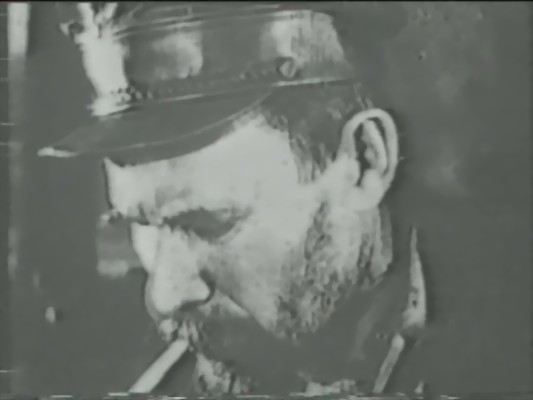
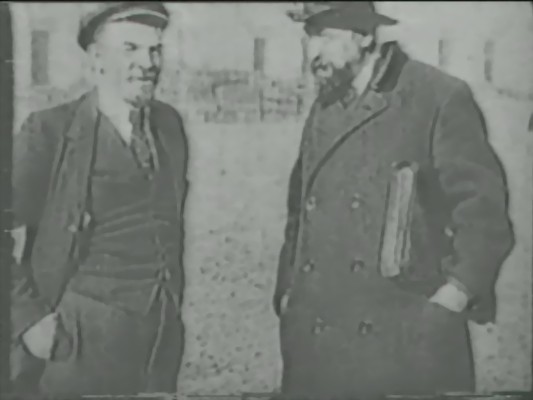
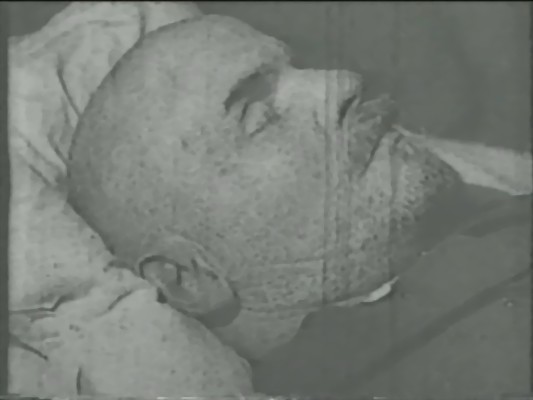
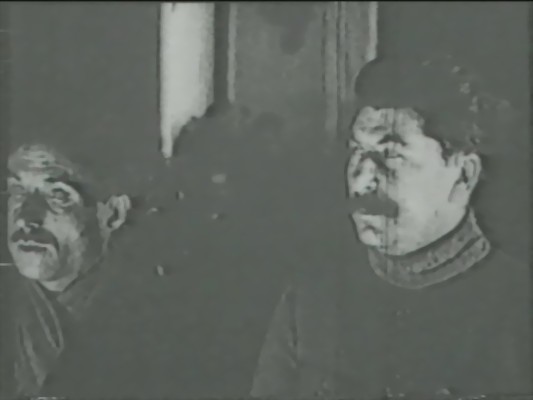
SILENT FILM WITH RUSSIAN INTERTITLES AND SWITCHABLE ENGLISH SUBTITLES. APPROXIMATELY 22 MINUTES.
KINO PRAVDA 22 (1925):
The "Peasant Kino Pravda" was made as part of the smychka campaign to unite workers and peasants and to demonstrate that "Lenin is Alive in the Heart of the Peasant", as well as in the hearts of oppressed Asians and Africans.
SILENT FILM WITH RUSSIAN INTERTITLES AND SWITCHABLE ENGLISH SUBTITLES. APPROXIMATELY 16 MINUTES.
KINO PRAVDA 23 (1925):
Country landscape, local post-office, people pick up packages. Children rush to meet the newcomers to the village. Villagers cut down trees, take them back to the village. People make poles, set up antennas. Village children and adults watch with interest and curiosity. Cartoon explanation of principles of telegraph and radio transmission. A telegraph station at work. First radio transmissions, people with headphones listening to concerts and speeches. Children learn about the radio.
SILENT FILM WITH RUSSIAN INTERTITLES AND SWITCHABLE ENGLISH SUBTITLES. THIS FILM HAS NO SOUND AT ALL. APPROXIMATELY 16 MINUTES.
UNLESS NOTED, ALL FILMS HAVE HAD SOUNDTRACKS ADDED BY US.
TOTAL RUNNING TIME: 138 MINUTES.
TOTAL RUNNING TIME FOR ALL THREE DISCS COMBINED: 294 MINUTES
PLEASE NOTE THAT SWITCHABLE (SOFT) SUBTITLES WILL NOT SHOW UP WHEN VIEWING THE SAMPLE BELOW. IF YOU SEE SUBTITLES, THEN THEY ARE HARD-ENCODED (meaning, they cannot be turned off when viewing the film):



